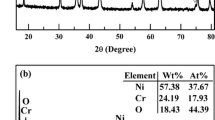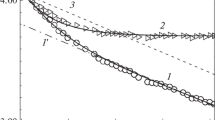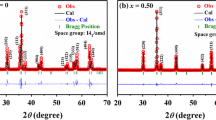Abstract
NiCr2O4/Cr2O3 system with ferrimagnetic spinel and antiferromagnetic transition metal oxide has been firstly synthesized by a chemical co-precipitation method. Magnetic measurements on this system also exhibit the exchange bias (EB) and training effect for the first time. EB effect with evident shift of coercive field and remnant magnetization can be detected at low temperature after field cooling from 350 K. The EB field can reach about 2037 Oe and the magnetization shift is as large as 0.129 emu/g at 10 K. Furthermore, EB effect recedes gradually with temperature increasing and disappears at about 70 K. In this process, EB field decreases with a linear dependence on the magnetization shift. This EB behavior is discussed according to the disordered regions existed at the interface between NiCr2O4 and Cr2O3. In addition, we have analyzed the training effect, which indicates the coexistence of two distinct forms of training mechanism during cycle procedure. One is concerned with an athermal impact resulting in the abrupt single cycle training and the other is gradual reduction of EB field during the subsequent cycles due to the conventional thermal activation mechanism.







Similar content being viewed by others
References
A.E. Berkowitz and K. Takano: Exchange anisotropy—A review. J. Magn. Magn. Mater. 200, 552 (1999).
S. Das, M. Patra, S. Majumdar, and S. Giri: Exchange bias effect at the irregular interfaces between Co and CoO nanostructures. J. Alloys Compd. 488, 27 (2009).
W.H. Meiklejohn and C.P. Bean: New magnetic anisotropy. Phys. Rev. 102, 1413 (1956).
B. Dieny, V.S. Speriosu, S.S.P. Parkin, B.A. Gurney, D.R. Wilhoit, and D. Mauri: Giant magnetoresistance in soft ferromagnetic multilayers. Phys. Rev. B 43, 1297 (1991).
J.C.S. Kools: Exchange-biased spin-valves for magnetic storage. IEEE Trans. Magn. 32, 3165 (1996).
R.K. Zheng, G.H. Wen, K.K. Fung, and X.X. Zhang: Training effect of exchange bias in γ-Fe2O3 coated Fe nanoparticles. Phys. Rev. B 69, 214431 (2004).
S. Guo, W. Liu, H. Meng, X.H. Liu, W.J. Gong, Z. Han, and Z.D. Zhang: Exchange bias and its training effect in Ni/NiO nanocomposites. J. Alloys Compd. 497, 10 (2010).
J. Nogués and I.K. Schuller: Exchange bias. J. Magn. Magn. Mater. 192, 203 (1999).
V. Skumryev, S. Stoyanov, Y. Zhang, G. Hadjipanayis, D. Givord, and J. Nogués: Beating the superparamagnetic limit with exchange bias. Nature 423, 850 (2003).
S.R. Mishra, I. Dubenko, J. Griffis, N. Ali, and K. Marasinghe: Exchange bias effect in ball milled Co–Cr2O3 FM–AFM nanocomposites. J. Alloys Compd. 485, 667 (2009).
J.B. Yi, J. Ding, Z.L. Zhao, and B.H. Liu: High coercivity and exchange coupling of Ni/NiO nanocomposite film. J. Appl. Phys. 97, 10K306 (2005).
M. Ptak, M. Maczka, A. Gagor, A. Pikul, L. Macalik, and J. Hanuza: Temperature-dependent XRD, IR, magnetic, SEM and TEM studies of Jahn–Teller distorted NiCr2O4 powders. J. Solid State Chem. 201, 270 (2013).
M.R. Suchomel, D.P. Shoemaker, L. Ribaud, M.C. Kemei, and R. Seshadri: Spin-induced symmetry breaking in orbitally ordered NiCr2O4 and CuCr2O4. Phys. Rev. B 86, 054406 (2012).
T.R. Mcguire, E.J. Scott, and F.H. Grannis: Antiferromagnetism in a Cr2O3 crystal. Phys. Rev. 102, 1000 (1956).
Z.M. Tian, S.L. Yuan, S.Y. Yin, L. Liu, J.H. He, H.N. Duan, P. Li, and C.H. Wang: Exchange bias effect in a granular system of NiFe2O4 nanoparticles embedded in an antiferromagnetic NiO matrix. Appl. Phys. Lett. 93, 222505 (2008).
M. Tadic, S.M. Savic, Z. Jaglicic, K. Vojisavljevic, A. Radojkovic, S. Prsic, and D. Nikolic: Magnetic properties of NiMn2O4−δ (nickel manganite): Multiple magnetic phase transitions and exchange bias effect. J. Alloys Compd. 588, 465 (2014).
M. Gruyters and D. Schmitz: Microscopic nature of ferro- and antiferromagnetic interface coupling of uncompensated magnetic moments in exchange bias systems. Phys. Rev. Lett. 100, 077205 (2008).
X.P. Qiu, D.Z. Yang, S.M. Zhou, R. Chantrell, K. O’Grady, U. Nowak, J. Du, X.J. Bai, and L. Sun: Rotation of the pinning direction in the exchange bias training effect in polycrystalline NiFe/FeMn bilayers. Phys. Rev. Lett. 101, 147207 (2008).
J. Barman, T. Bora, and S. Ravi: Study of exchange bias and training effect in NiCr2O4. J. Magn. Magn. Mater. 385, 93 (2015).
H. Singh, T. Chakraborty, K. Srikanth, R. Chandra, C. Mitra, and U. Kumar: Study of exchange bias in NiCr2O4 nanoparticles. Phys. B 448, 77 (2014).
A. Hochstrat, Ch. Binek, and W. Kleemann: Training of the exchange-bias effect in NiO–Fe heterostructures. Phys. Rev. B 66, 092409 (2002).
A. Hoffmann: Symmetry driven irreversibilities at ferromagnetic–antiferromagnetic interfaces. Phys. Rev. Lett. 93, 097203 (2004).
D. Paccard, C. Schlenker, O. Massenet, R. Montmory, and A. Yelon: A new property of ferromagnetic–antiferromagnetic coupling. Phys. Status Solidi 16, 301 (1966).
M.K. Chan, J.S. Parker, P.A. Crowell, and C. Leighton: Identification and separation of two distinct contributions to the training effect in polycrystalline Co/FeMn bilayers. Phys. Rev. B 77, 014420 (2008).
T. Dias, E. Menéndez, H. Liu, C.V. Haesendonck, A. Vantomme, K. Temst, J.E. Schmidt, R. Giulian, and J. Geshev: Rotatable anisotropy driven training effects in exchange biased Co/CoO films. J. Appl. Phys. 115, 243903 (2014).
ACKNOWLEDGMENTS
This work is supported by the National Natural Science Foundation of China (Grant Nos. 11174092 and 11474111). We would like to thank the staff of Analysis Center of HUST for their assistance in various measurements.
Author information
Authors and Affiliations
Corresponding author
Rights and permissions
About this article
Cite this article
Liguang, W., Changming, Z., Zhaoming, T. et al. Exchange bias and training effect in NiCr2O4/Cr2O3 composite. Journal of Materials Research 30, 3252–3258 (2015). https://doi.org/10.1557/jmr.2015.272
Received:
Accepted:
Published:
Issue Date:
DOI: https://doi.org/10.1557/jmr.2015.272




